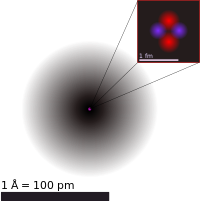
Photo from wikipedia
The local coordination structure of metal sites essentially determines the performance of supported metal catalysts. Using a surface defect enrichment strategy, we successfully fabricated Pt atomic single-layer (PtASL) structures with… Click to show full abstract
The local coordination structure of metal sites essentially determines the performance of supported metal catalysts. Using a surface defect enrichment strategy, we successfully fabricated Pt atomic single-layer (PtASL) structures with 100% metal dispersion and precisely controlled local coordination environment (embedded vs adsorbed) derived from Pt single-atoms (Pt1) on ceria-alumina supports. The local coordination environment of Pt1 not only governs its catalytic activity but also determines the Pt1 structure evolution upon reduction activation. For CO oxidation, the highest turnover frequency can be achieved on the embedded PtASL in the CeO2 lattice, which is 3.5 times of that on the adsorbed PtASL on the CeO2 surface and 10-70 times of that on Pt1. The favorable CO adsorption on embedded PtASL and improved activation/reactivity of lattice oxygen within CeO2 effectively facilitate the CO oxidation. This work provides new insights for the precise control of the local coordination structure of active metal sites for achieving 100% atomic utilization efficiency and optimal intrinsic catalytic activity for targeted reactions simultaneously.
Journal Title: Journal of the American Chemical Society
Year Published: 2022
Link to full text (if available)
Share on Social Media: Sign Up to like & get
recommendations!